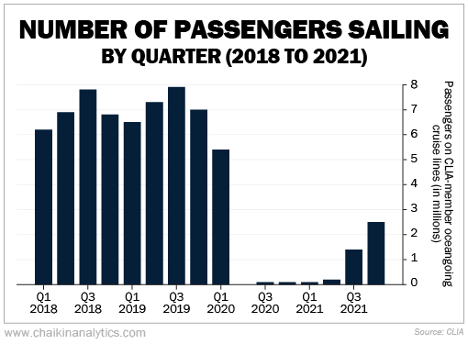Editor’s Note: Today, we’re sharing an essay from Marc Chaikin, a 50-year Wall Street legend and founder of our corporate affiliate, Chaikin Analytics. As he explains below, adapted from a recent PowerFeed daily e-letter, unpredicted events can have a ripple through the markets for years. But investors who set themselves up for success through long-term disruptions are often rewarded.
Mr. Wu probably didn’t expect to be called “patient zero” when he left a ship with a cough…
Wu was a retired physical education teacher living off a pension in Hong Kong. At 80 years old, he was still in relatively good health. And he could get around the city by himself.
He was content living the rest of his golden years in a public housing estate provided by the government.
But earlier that month, his two daughters surprised him…
They gifted Wu an all-expenses-paid vacation around Asia on a luxury cruise ship called the Diamond Princess. It was supposed to be one of the most extravagant vacations of his life.
On January 17, 2020, Wu and his daughters got on a plane to Japan, where the Diamond Princess was docked. The ship would be departing three days later.
However, Wu had developed a cough. At his age, getting sick onboard a ship wasn’t good.
The Diamond Princess docked in Hong Kong on January 25. Only five days into the journey, Wu and other passengers disembarked. They didn’t return to finish the rest of the trip.
The ship then set off for Vietnam… then Taiwan… and back to Japan. Then, on February 1, the captain got a call. It was the Hong Kong Centre for Health Protection.
The agency said that an 80-year-old passenger named Wu had tested positive for a new, potentially fatal virus that was wreaking havoc in China.
You can probably guess the name…
Wu had tested positive for COVID-19. And he eventually started getting labeled as “patient zero.”
By the time the Diamond Princess returned to its port of origin in Japan, Hong Kong was starting to implement border controls. And new COVID-19 cases had been confirmed as far as the U.K.
Meanwhile, the Diamond Princess was put under quarantine – along with all its passengers and crew.
Over the next two weeks, about 700 of the folks that were onboard tested positive for COVID-19. And for a while, the Diamond Princess had the highest reported number of infected people anywhere outside of China.
It wasn’t just the Diamond Princess…
A Colossal Blow to the Cruise Industry
Soon, other cruise ships began reporting their own localized outbreaks.
Despite early efforts to contain the virus in Asia, it was too late. Free-flowing travel in other parts of the world drove infections up to 1 million by the start of April. Several weeks later, the virus had infected 10 million people.
In the U.S., the Centers for Disease Control and Prevention (“CDC”) issued a No Sail Order on March 14.
As you would expect, this devastated the cruise industry. The quarterly number of passengers sailing on cruise lines completely collapsed.
Take a look at the chart below from the Cruise Lines International Association (“CLIA”)…
Even after the CDC lifted its No Sail Order in October 2020, CLIA was cautious. It decided to extend its suspension of U.S. activities for the rest of the year.
A total of $25 billion in economic activity went up in smoke. And 164,000 jobs in the U.S. cruise industry were lost.
Cruise-line operators had to survive by incurring debt to keep ships in good condition and staff employed… even with no passenger travel.
Many folks wrote off the industry for dead. They thought that the days of cruise-ship travel were over.
But they couldn’t have been more mistaken…
The Cruise Industry’s Huge Recovery
As you know, COVID-19 crushed the global economy. But the world adapted. Businesses started to reopen with the help of masks, vaccines, and social distancing. By the end of 2020, U.S. lockdowns had wound down.
Over the next couple of quarters, the world’s remaining major cruise-ship operators focused on cutting costs. This included scrapping old and inefficient ships. A total of 35 ships would end up being scrapped between 2020 and 2022.
By May 2021, the CDC relaxed rules on cruise operations. Operators could return to normal business as long as crew members and passengers had received a COVID-19 vaccine.
Then, in June 2021, the CDC finally lowered its warning against cruise travel for the first time since the pandemic started.
The cruise industry had started to recover. People wanted to travel.
Take a look at the incredible rebound in passenger numbers…
To say that the global cruise industry experienced a remarkable recovery over the past four years would be an understatement. It practically rose from the dead. Passenger numbers went on to surge above pre-pandemic levels.
This next chart from the CLIA helps put the pandemic years in perspective…
And the numbers are expected to keep growing. This year, the global cruise industry is expected to serve 37.7 million passengers and replicate its 9% annual growth last year.
Folks, this is an important lesson in investing…
It takes time for big, macroeconomic events to unfold.
Often, investors have moved on from a particular story. And in this case, COVID-19 might seem like “old news” to you.
But as you’ve seen, its effects are still rippling through the market. And while folks assumed an industry like cruise ships was doomed… passenger travel went on to soar to new heights.
Sometimes, it pays to be patient.
Good investing,
Marc Chaikin
Editor’s Note: Marc Chaikin called the 2020 crash and the 2022 bear market. And as we enter into an uncertain October, he sees a surprising market shift coming in the next 90 days. And Marc’s little-known strategy could help you lock in rapid returns and shield your wealth from the incoming volatility. So, if you have money in the market, you’ll want to see his newest update here.
|



